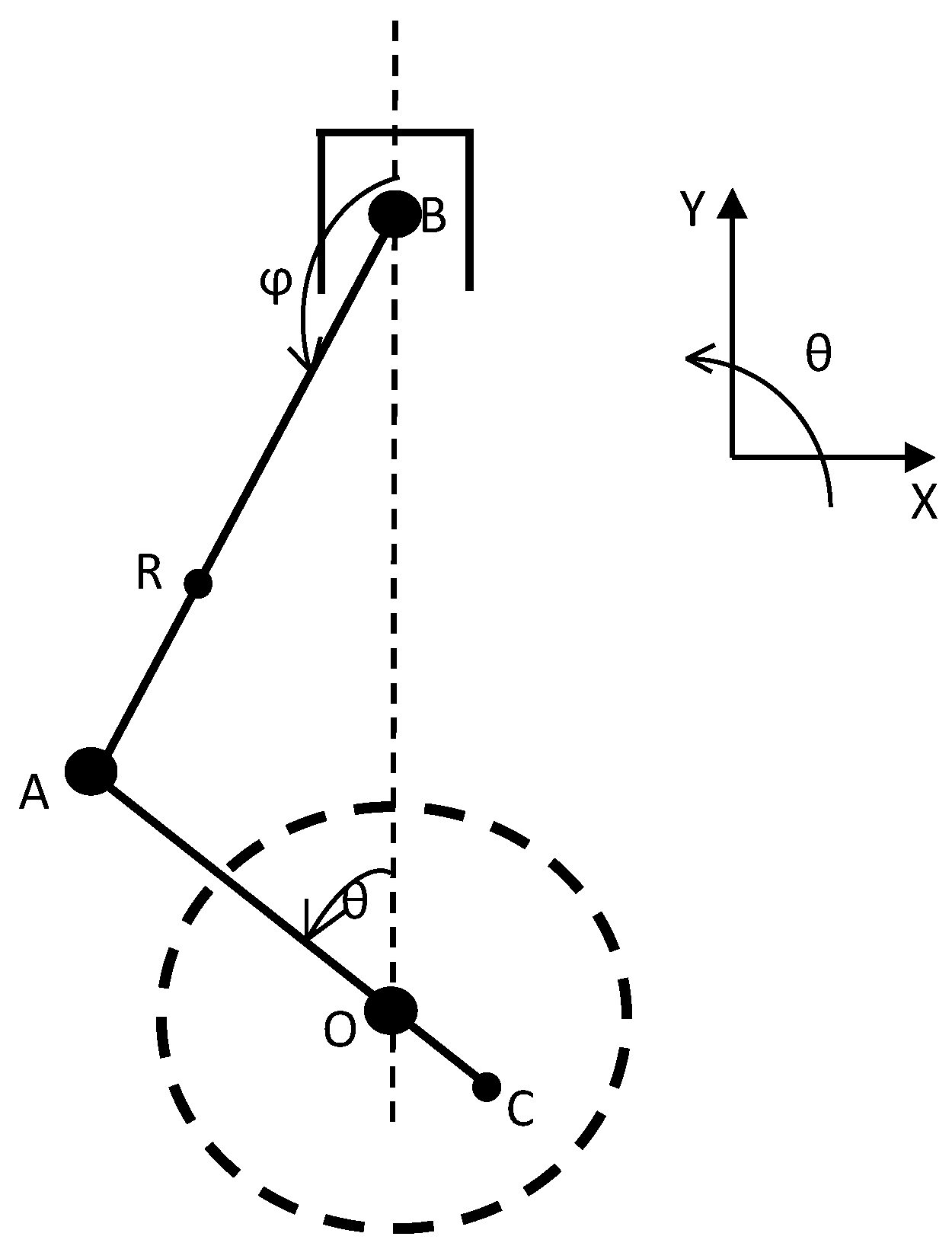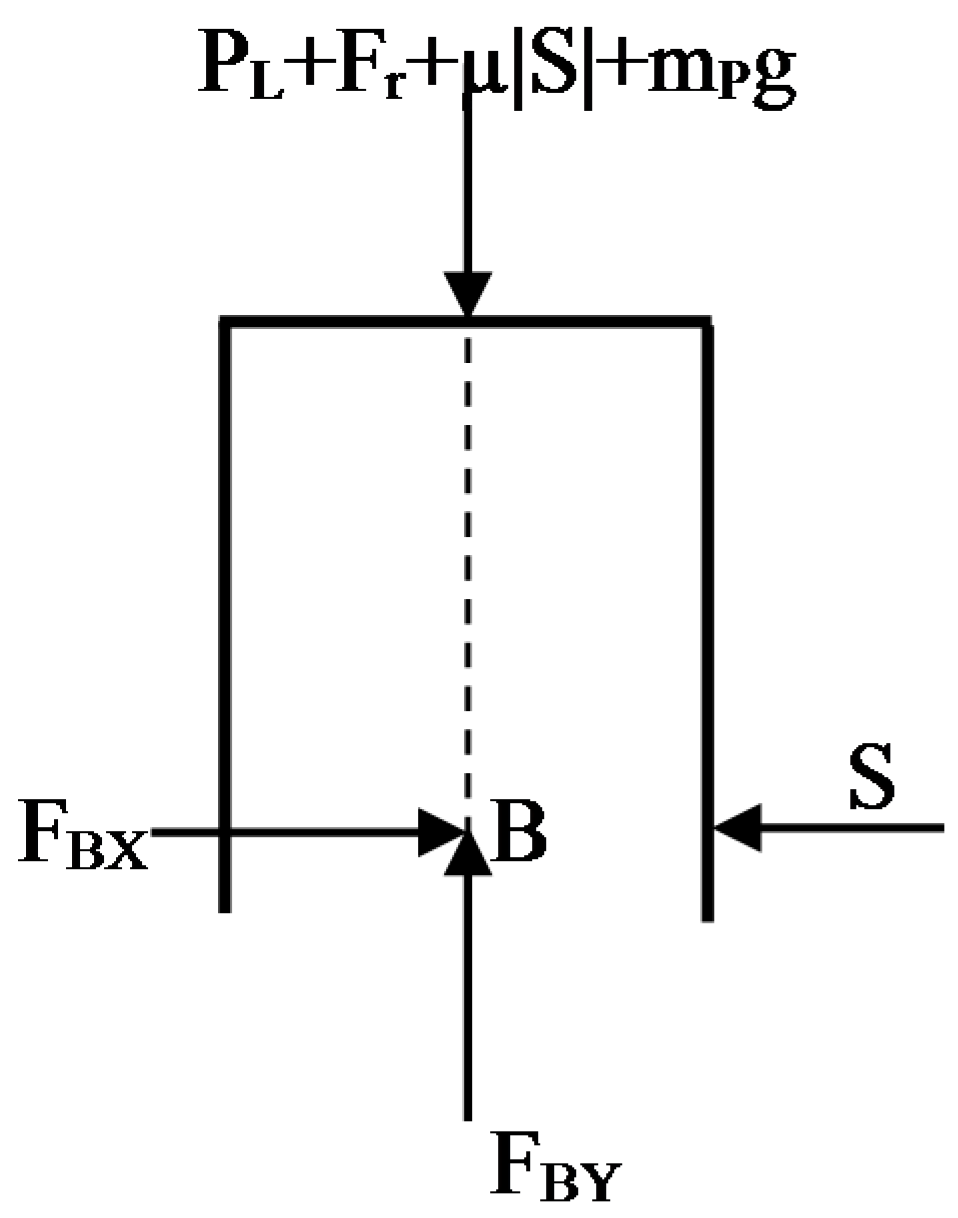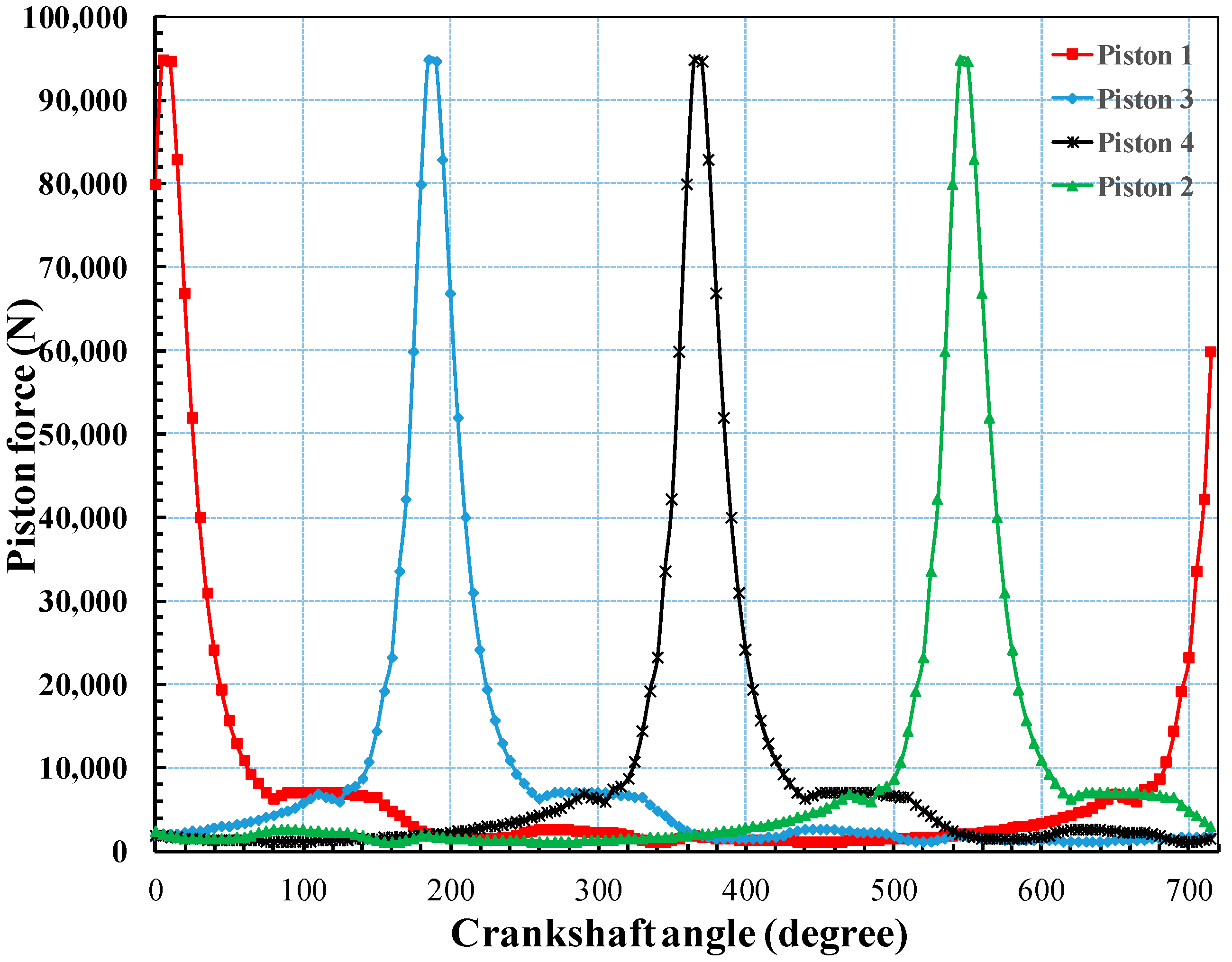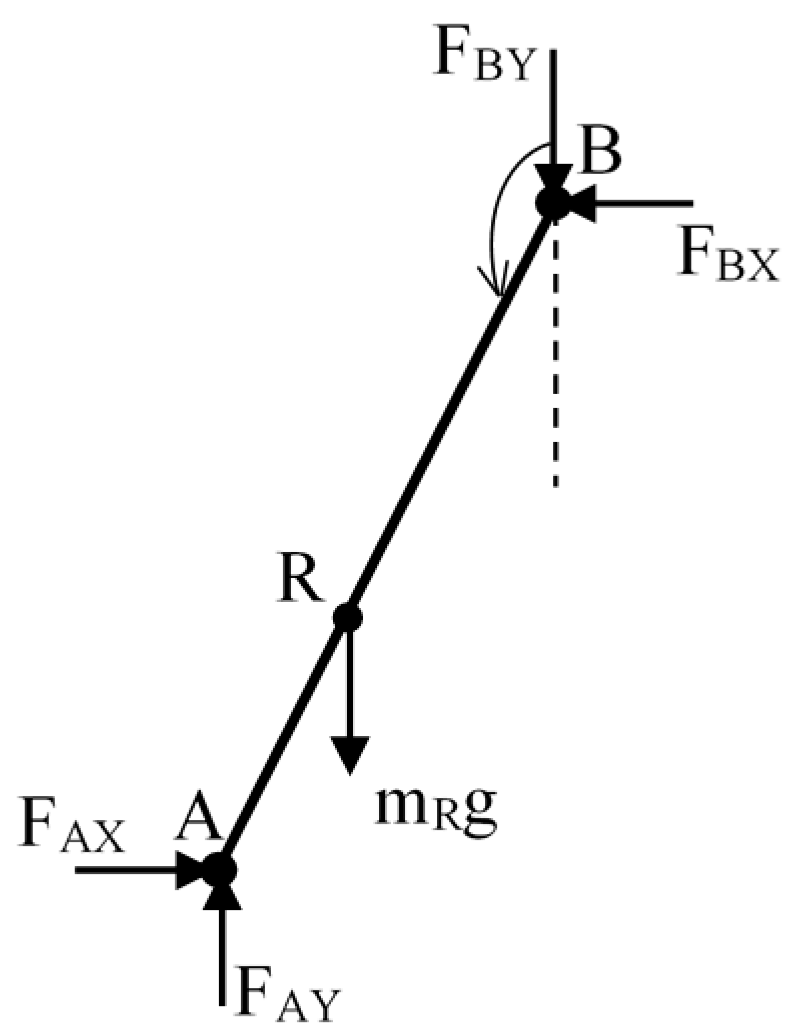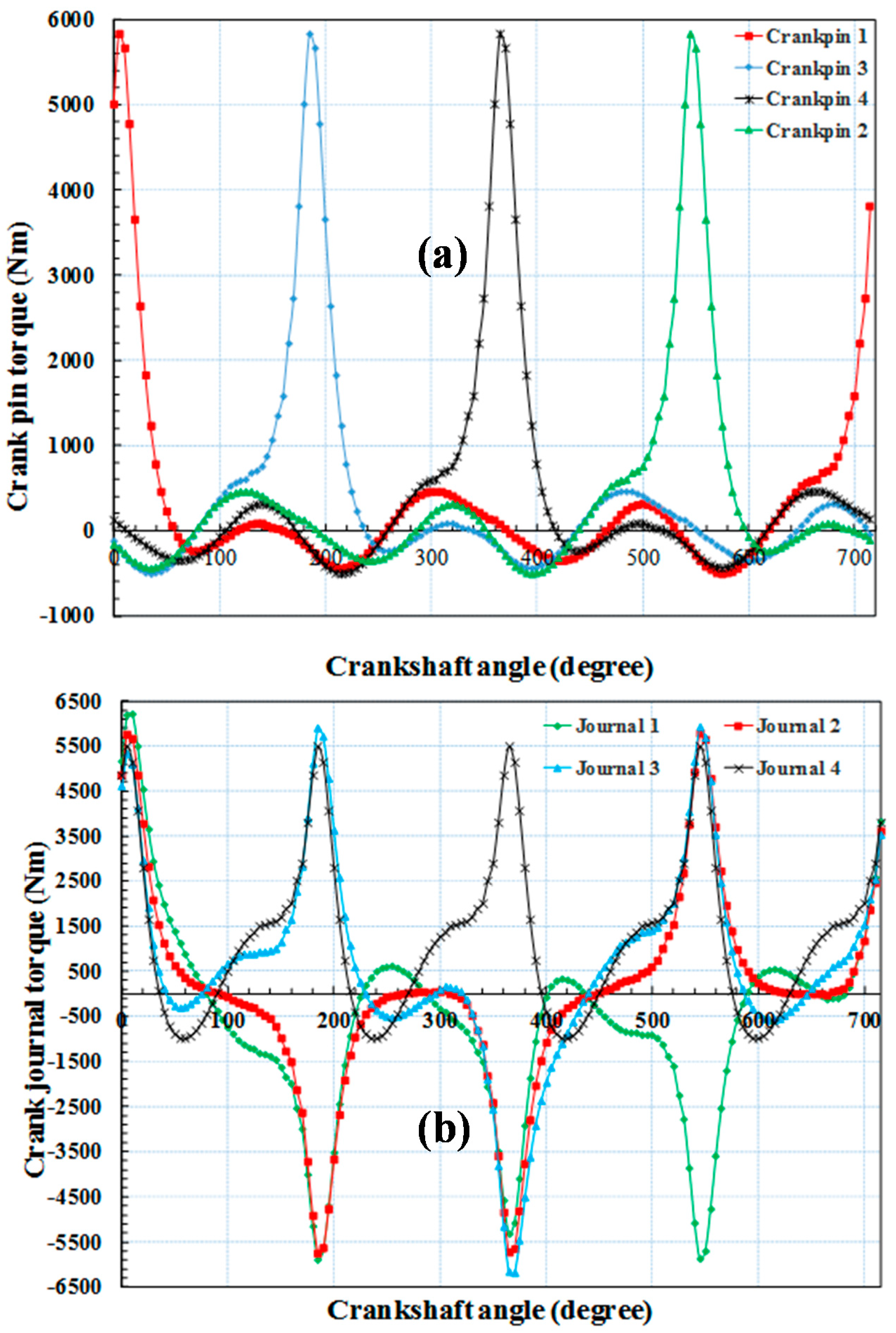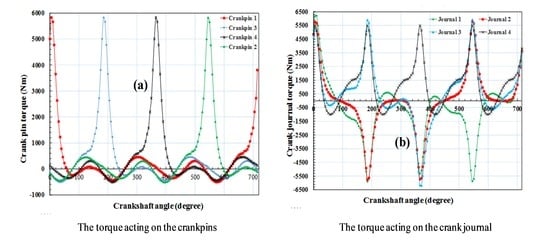The pressure
p exerts a force on the piston
m1 to create movement along the axis of the transmission cylinder to the transfer bar
m2 of the parallel plane, causing the crankshaft
m3 to rotate around the center
O.
m1 is the mass of the piston,
m2 is the mass of the rod,
m3 is the mass of the crankshaft,
l2 is the length of the rod,
l3 is the crankshaft length,
p is the pressure on the piston surface,
θ is the angle between the crankshaft and the vertical axis, and
ϕ is the angle between the rod and the vertical axis (
Figure 2).
3.1. In-Cylinder Pressure and Friction Force Calculation
During the operation of internal combustion engines, combustion is an irreversible process that uses the reactions of fuel with an oxidizer to convert chemical energy into sensible energy, which also works to form products. In practice, carbon dioxide (CO2), nitrogen, and water are the main products of the combustion process. However, other species, including nitric oxide, nitrogen oxide, carbon monoxide, hydrocarbon, and particulate matter, are also common products. The liquid state determination at each point in the process requires a detailed understanding of the intermediate reactions that change the original mixture into the final combustion products. However, in all cases, we can use the first law of thermodynamics to determine the correlation between the beginning and end of a combustion process.
The application of this law does not require users to know the development of the intermediate stages of the process. The first law of thermodynamics expresses the relationship between the variation of the internal energy (or enthalpy) and that of heat and work. When applying this law to a system where the chemical composition changes, we need to determine the zero state of the internal energy or enthalpy of all the substances in the system.
In specific cases, the calculation of combustion in internal combustion engines is based on the equation of the first law of thermodynamics:
where
is the change in internal energy inside the cylinder,
is the work cycle,
is the heat input,
is the heat loss through the wall,
is the enthalpy loss due to gas leakage,
is the volume of the liquid inside the cylinder,
is the internal energy,
is the pressure inside the cylinder,
is the cylinder volume,
is the heat of the fuel supply,
is the heat loss to the wall,
α is the angle of the crankshaft rotation,
is the enthalpy value, and
is the variation in volumetric flow rate.
Equation (1) applies to both internal and external composite engines. However, the changes in the composition of the two cases are different. In the case of the formation of a mixture inside a cylinder, if we assume that the fuel in the cylinder is burned immediately, the combustion mixture is immediately blended with the residual gas in the cylinder. The air-fuel ratio (A/F) decreases continuously from a high value at the starting point to a low value at the end of the combustion. After the transformation, Equation (1) becomes:
where
Tc is the cylinder temperature,
mc is the volume of the fluid in the cylinder,
pc is the pressure in the cylinder,
uc is the specific internal energy of the volume of liquid inside the cylinder,
Hc is the low calorific value,
λ is the air residue ratio (1/Φ), α is the equivalent ratio, and
Vc is the cylinder volume.
The solution of the above equation depends on the combustion model, the laws of exothermic reactions, and the heat transfer through the cylinder wall, as well as the pressure, temperature, and composition of the gas mixture together with the equation of the state:
Establishing the relationship between pressure, temperature, and density from Equation (3), we used the Runge–Kutta method to determine the temperature of the cylinder. The pressure will then be determined by the state equation.
Figure 3 shows the in-cylinder pressure profile using the experimental and numerical methods. The in-cylinder pressure always changes according to the crankshaft angle. The in-cylinder pressure is nominal at the intake and exhaust strokes; however, it increases dramatically during the compression and power strokes. It reaches a very high value at the position near the top dead center. From there, we determined the force
caused by the pressure applied to the top of the piston.
In addition, the crankcase pressure generated by oil pressure on the underside is normally determined in the experiment. This force is very small compared to the total force exerted on the top of the piston. Consequently, it was ignored in this research. Furthermore, the friction force (
Ffr) exerted on the piston needed to be determined in this calculated case.
Ffr includes the piston-ring friction (
Fr) and the friction from the piston surface and cylinder (
μpS). The total friction force can be calculated according to Equation (4) [
15,
16].
where
μr is the friction coefficient of the contact surface between the ring and cylinder,
D3 is the diameter of the cylinder,
d4 is the diameter of the ram,
r is the width of the cross-section of the cylinder element,
E is the elastic coefficient of the spring materials,
S is the force resulting from the contact between the piston and the cylinder, and
μp is the corresponding friction coefficient.
The sliding friction is dramatically reduced by adding a lubricant between the contact surfaces. In addition, in the operation of an internal combustion engine, the piston ring operates from the hydrodynamic lubrication to the boundary lubrication depending on the crankshaft angle, viscosity, and load. This phenomenon can be described by Stribeck’s equation [
17]. In this research, the friction coefficient
µr was determined using Stribeck’s equation as described in Equation (5):
where
c is constant,
h is the dynamic viscosity,
v is the piston speed,
p is the pressure exerted on the piston ring,
w is the width of the ring, and
x is the exponent varying from 0.33 to 0.66. Therefore, we calculated the total friction force based on the number and parameter characteristics of the test engine. The inertia force caused by the movement of the piston and rod was also dramatically affected by the piston; it will be described in the following sections.
3.2. Kinetics and Dynamics of the Piston Mechanism
According to [
18], assuming the displacement of the piston in the horizontal direction is trivial, applying the sine theorem in the OAB triangle (
Figure 2), we have:
If we derive the above expression, we have:
The
z displacement of the piston in the vertical direction is defined by:
We can infer that the velocity of the piston in the vertical direction is determined by Equation (8) and the acceleration of the piston in the vertical direction can be calculated with Equation (9).
The piston moves only along the cylinder, and thus the acceleration in the horizontal and vertical directions across the piston are determined in Equations (10) and (11), respectively.
The cylinder has actually become elliptical due to the rotation of the piston about the wrist pin when the piston moves toward the bottom dead center. In addition, the high temperature during the operation process also affects the deformation of the piston and cylinder. Consequently, the forces exerted on the piston are not symmetric in the x direction. However, in this research, we assumed that the forces exerted on the piston were symmetric in the x direction. Therefore, the forces acting on the piston include
Q(t), the total external force acting on the piston,
mP.g, the force of gravity, and
FBX, FBY, the link reaction forces in the
x and
y directions, respectively [
17,
19], as described in
Figure 4.
Since the piston does not move in the
x direction, the total force acting on
x is zero, inferring that:
The total force acting in the
y direction is:
where
Q(t) is the total external force acting on the piston, including the force acting on the piston (
PT), the friction caused by the impacts on the cylinder wall (
Fr), friction from the piston surface and cylinder (
μpS), the force caused by pressure acting on the piston bottom (
PB is crankcase pressure), and the inertia force
.
From Equation (13), we infer that the reaction force on the piston in the y direction is:
in which:
Note that the sign of
μpS depends on the direction of piston movements. Thus, we obtained a graph illustrating the total force on the pistons of the test engine, as shown in
Figure 5.
3.4. Kinetics and Dynamics of the Crankshaft
The crankshaft converts the up and down movements of the pistons into rotary motion and drives the external drive. The crankshaft is connected to the pistons via the transmission rods.
Similar to the determination of the rod acceleration, we can determine the crankshaft acceleration at the center using the acceleration at the common point between the transmission rod and the crankshaft
and project it in the horizontal and vertical directions:
The total force acting on the crankshaft is illustrated in
Figure 7.
The total force in
x direction is:
The total force acting in the
y direction is:
The total torque around crankshaft is:
Combining these above equations, we have:
Substituting the known forces in Equation (8), we can obtain the torque acting on the crankshaft:
Substituting the known accelerations into the above equation, we have:
where
I(θ) is the inertia function, defined by:
where
I’(θ) is the rate of the inertial variable based on the rotational angle
θ of the crankshaft determined by:
where
g(θ) is the gravitational torque, determined by:
and
Q(t,θ) is the momentum or torque determined by the general load
Q(t) acting on the piston, determined by:
With the input pressure as mentioned in
Figure 3 acting on the top of the piston, corresponding to the engine speed of 2200 rpm, and using a firing order of 1–3–4–2, we can determine the average load moment on the crankshaft over the entire cycle as follows:
Figure 8a shows the torque acting on the four crankpins of the crankshaft. The maximum torque on each crankpin occurs when the crankshaft is positioned in the range of 360° to 370°, immediately after the top dead center. The main torque exerted on the crankpins is the in-cylinder pressure; however, the friction and inertia force also dramatically contribute to the total force varying according to the crankshaft angle. For instance, at the crankshaft angle of 363°, the total torque exerted on crankpin 1 reaches a maximum value of 6203 Nm. Meanwhile, the inertia force and the friction force contribute to approximately 8.9% and 4.6% of the total torque, respectively.
Figure 8b shows the torque acting on the main journals of the crankshaft. They also vary depending on the crankshaft angle. However, the torque of each main journal is dramatically different from one other since it is calculated based on the different torque directions acting on the adjacent crankpins.

